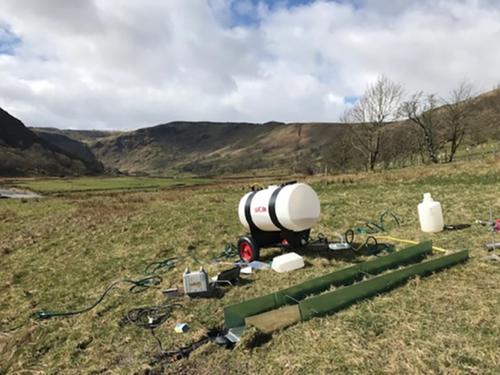当前位置:
X-MOL 学术
›
Hydrol. Process.
›
论文详情
Our official English website, www.x-mol.net, welcomes your feedback! (Note: you will need to create a separate account there.)
Seasonal vegetation and management influence overland flow velocity and roughness in upland grasslands
Hydrological Processes ( IF 3.2 ) Pub Date : 2020-07-06 , DOI: 10.1002/hyp.13842 Stephanie Bond 1 , Mike J. Kirkby 1 , Jean Johnston 2 , Alistair Crowle 3 , Joseph Holden 1
Hydrological Processes ( IF 3.2 ) Pub Date : 2020-07-06 , DOI: 10.1002/hyp.13842 Stephanie Bond 1 , Mike J. Kirkby 1 , Jean Johnston 2 , Alistair Crowle 3 , Joseph Holden 1
Affiliation

|
There is considerable interest in how headwater management may influence downstream flood peaks in temperate humid regions. However, there is a dearth of data on flow velocities across headwater hillslopes and limited understanding of whether surface flow velocity is influenced by seasonal changes in roughness through vegetation cycles or management. A portable hillslope flume was used to investigate overland flow velocities for four common headwater grassland habitats in northern England: Low‐density Grazing, Hay Meadow, Rank Grassland and Juncus effusus Rush pasture. Overland flow velocity was measured in replicate plots for each habitat, in response to three applied flow rates, with the experiments repeated during five different periods of the annual grassland cycle. Mean annual overland flow velocity was significantly lower for the Rank Grassland habitat (0.026 m/s) followed by Low‐density Grazing and Rushes (0.032 and 0.029 m/s), then Hay Meadows (0.041 m/s), which had the greatest mean annual velocity (examples from 12 L/min flow rate). Applying our mean overland flow velocities to a theoretical 100 m hillslope suggests overland flow is delayed by >1 hr on Rank Grassland when compared to Hay Meadows in an 18 mm storm. Thus grassland management is important for slowing overland flow and delaying peak flows across upland headwaters. Surface roughness was also strongly controlled by annual cycles of vegetation growth, decay, grazing and cutting. Winter overland flow velocities were significantly higher than in summer, varying between 0.004 m/s (Rushes, November) and 0.034 m/s (Rushes, June); and velocities significantly increased after cutting varying between 0.006 m/s (Hay meadows, July) and 0.054 m/s (Hay meadows, September). These results show that seasonal vegetation change should be incorporated into flood modelling, as cycles of surface roughness in grasslands strongly modify overland flow, potentially having a large impact on downstream flood peak and timing. Our data also showed that Darcy‐Weisbach roughness approximations greatly over‐estimated measured flow velocities.
中文翻译:

季节植被和管理方式影响旱地草地流速和粗糙度
人们非常关注源头管理如何影响温带湿润地区的下游洪峰。但是,缺乏跨源头山坡的流速数据,并且对地表流速是否受植被周期或管理过程中的季节性季节性变化影响的了解有限。便携式山坡水槽用于调查英格兰北部四种常见的上游水生草地栖息地的陆流速度:低密度放牧,干草草甸,兰克草地和Jun草草场。响应三种施加的流速,在每个栖息地的重复样地中测量了陆上流速,并在年度草地循环的五个不同时期重复了该实验。等级草地生境的年平均陆上流速明显较低(0.026 m / s),其次是低密度放牧和冲刷(0.032和0.029 m / s),然后是干草草甸(0.041 m / s),最大年平均速度(例如12 L / min流量)。将我们的平均陆流速度应用于理论上100 m的山坡,表明与18 mm暴风雨中的Hay Meadows相比,Rank草原的陆流延迟了1小时以上。因此,草地管理对于减缓陆上水流和延迟跨高地源头的峰值水流很重要。表面粗糙度还受到植被生长,腐烂,放牧和砍伐的年度周期的强烈控制。冬季的陆上流速比夏季高得多,介于0.004 m / s(鲁什,11月)和0.034 m / s(鲁什,6月)之间。切割后的速度显着增加,介于0.006 m / s(7月的干草草甸)和0.054 m / s(9月的干草草甸)之间。这些结果表明,季节性植被变化应纳入洪水模型中,因为草原的地表粗糙度周期会强烈改变陆上水流,从而可能对下游洪灾高峰和时机产生重大影响。我们的数据还显示,Darcy-Weisbach粗糙度近似值大大高估了测得的流速。冬季的陆上流速比夏季高得多,介于0.004 m / s(鲁什,11月)和0.034 m / s(鲁什,6月)之间。切割后的速度显着增加,介于0.006 m / s(7月的干草草甸)和0.054 m / s(9月的干草草甸)之间。这些结果表明,季节性植被变化应纳入洪水模型中,因为草地的表面粗糙度周期会强烈改变陆上水流,从而可能对下游洪灾高峰和时机产生重大影响。我们的数据还显示,Darcy-Weisbach粗糙度近似值大大高估了测得的流速。冬季的陆上流速比夏季高得多,介于0.004 m / s(鲁什,11月)和0.034 m / s(鲁什,6月)之间。切割后的速度显着增加,介于0.006 m / s(7月的干草草甸)和0.054 m / s(9月的干草草甸)之间。这些结果表明,季节性植被变化应纳入洪水模型中,因为草地的表面粗糙度周期会强烈改变陆上水流,从而可能对下游洪灾高峰和时机产生重大影响。我们的数据还显示,Darcy-Weisbach粗糙度近似值大大高估了测得的流速。054 m / s(干草草甸,9月)。这些结果表明,季节性植被变化应纳入洪水模型中,因为草地的表面粗糙度周期会强烈改变陆上水流,从而可能对下游洪灾高峰和时机产生重大影响。我们的数据还显示,Darcy-Weisbach粗糙度近似值大大高估了测得的流速。054 m / s(干草草甸,9月)。这些结果表明,季节性植被变化应纳入洪水模型中,因为草地的表面粗糙度周期会强烈改变陆上水流,从而可能对下游洪灾高峰和时机产生重大影响。我们的数据还显示,Darcy-Weisbach粗糙度近似值大大高估了测得的流速。
更新日期:2020-07-06
中文翻译:

季节植被和管理方式影响旱地草地流速和粗糙度
人们非常关注源头管理如何影响温带湿润地区的下游洪峰。但是,缺乏跨源头山坡的流速数据,并且对地表流速是否受植被周期或管理过程中的季节性季节性变化影响的了解有限。便携式山坡水槽用于调查英格兰北部四种常见的上游水生草地栖息地的陆流速度:低密度放牧,干草草甸,兰克草地和Jun草草场。响应三种施加的流速,在每个栖息地的重复样地中测量了陆上流速,并在年度草地循环的五个不同时期重复了该实验。等级草地生境的年平均陆上流速明显较低(0.026 m / s),其次是低密度放牧和冲刷(0.032和0.029 m / s),然后是干草草甸(0.041 m / s),最大年平均速度(例如12 L / min流量)。将我们的平均陆流速度应用于理论上100 m的山坡,表明与18 mm暴风雨中的Hay Meadows相比,Rank草原的陆流延迟了1小时以上。因此,草地管理对于减缓陆上水流和延迟跨高地源头的峰值水流很重要。表面粗糙度还受到植被生长,腐烂,放牧和砍伐的年度周期的强烈控制。冬季的陆上流速比夏季高得多,介于0.004 m / s(鲁什,11月)和0.034 m / s(鲁什,6月)之间。切割后的速度显着增加,介于0.006 m / s(7月的干草草甸)和0.054 m / s(9月的干草草甸)之间。这些结果表明,季节性植被变化应纳入洪水模型中,因为草原的地表粗糙度周期会强烈改变陆上水流,从而可能对下游洪灾高峰和时机产生重大影响。我们的数据还显示,Darcy-Weisbach粗糙度近似值大大高估了测得的流速。冬季的陆上流速比夏季高得多,介于0.004 m / s(鲁什,11月)和0.034 m / s(鲁什,6月)之间。切割后的速度显着增加,介于0.006 m / s(7月的干草草甸)和0.054 m / s(9月的干草草甸)之间。这些结果表明,季节性植被变化应纳入洪水模型中,因为草地的表面粗糙度周期会强烈改变陆上水流,从而可能对下游洪灾高峰和时机产生重大影响。我们的数据还显示,Darcy-Weisbach粗糙度近似值大大高估了测得的流速。冬季的陆上流速比夏季高得多,介于0.004 m / s(鲁什,11月)和0.034 m / s(鲁什,6月)之间。切割后的速度显着增加,介于0.006 m / s(7月的干草草甸)和0.054 m / s(9月的干草草甸)之间。这些结果表明,季节性植被变化应纳入洪水模型中,因为草地的表面粗糙度周期会强烈改变陆上水流,从而可能对下游洪灾高峰和时机产生重大影响。我们的数据还显示,Darcy-Weisbach粗糙度近似值大大高估了测得的流速。054 m / s(干草草甸,9月)。这些结果表明,季节性植被变化应纳入洪水模型中,因为草地的表面粗糙度周期会强烈改变陆上水流,从而可能对下游洪灾高峰和时机产生重大影响。我们的数据还显示,Darcy-Weisbach粗糙度近似值大大高估了测得的流速。054 m / s(干草草甸,9月)。这些结果表明,季节性植被变化应纳入洪水模型中,因为草地的表面粗糙度周期会强烈改变陆上水流,从而可能对下游洪灾高峰和时机产生重大影响。我们的数据还显示,Darcy-Weisbach粗糙度近似值大大高估了测得的流速。



























 京公网安备 11010802027423号
京公网安备 11010802027423号